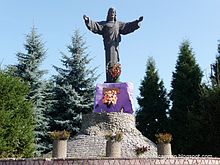Kernyzja
| Kernyzja | ||
| Керниця | ||

|
|
|
| Basic data | ||
|---|---|---|
| Oblast : | Lviv Oblast | |
| Rajon : | Horodok district | |
| Height : | 281 m | |
| Area : | 16.66 km² | |
| Residents : | 1,500 (2001) | |
| Population density : | 90 inhabitants per km² | |
| Postcodes : | 81550 | |
| Area code : | +380 3231 | |
| Geographic location : | 49 ° 47 ' N , 23 ° 45' E | |
| KOATUU : | 4620983901 | |
| Administrative structure : | 5 villages | |
| Address: | 81 550 с. Керниця | |
| Statistical information | ||
|
|
||
Kernyzja ( Ukrainian Керниця ; Russian Керница Kerniza , Polish Kiernica or Krynica ) is a village in the western Ukrainian Lviv Oblast with about 1500 inhabitants.
It belongs with the villages Artyschtschiw ( Артищів ), Lyubowytschi ( Любовичі ), Mawkowytschi and Velyka Kalynka ( Велика Калинка ) to the district council of the same name .
history
The place was originally called Szczuczenosy in Polish (e.g. Sczuczenossy in 1465). The current name appeared in 1463 ( Cry (nycza) districtu Grodecensi sittas ) and later as Crinycza (1469), Krynycza (1473), Krinicza (1578), Kiernica (1777). The name refers to source , sparkling .
It initially belonged to the Lviv region in the Ruthenian Voivodeship of the aristocratic republic of Poland-Lithuania . During the first partition of Poland in 1772 the village became part of the new Kingdom of Galicia and Lodomeria of the Habsburg Empire (from 1804).
In 1848 a Mennonite settlement was established there , which in 1909 was organized as the Kiernica-Lemberg community, the first official and the only Mennonite community in Galicia. The Chrześcijańsko-mennonicka Gmina Kiernica-Lwów was one of only six Mennonite communities in Poland in the interwar period.
In 1900 the municipality of Kiernica had 239 houses with 1441 inhabitants, of which 1336 were Ruthenian-speaking, 105 Polish-speaking, 1334 Greek-Catholic, 81 Roman-Catholic, 21 Jews, 5 of other faiths. In the manor there were 17 houses with 163 inhabitants, 54 of them other beliefs (Mennonites).
After the end of the Polish-Ukrainian War in 1919, the community became part of Poland. In 1921 the municipality of Kiernica had 351 houses with 1918 inhabitants, of which 1764 Ruthenians, 131 Poles, 6 Germans, 17 Jews (nationality), 1781 Greek Catholics, 92 Roman Catholics, 40 Jews (religion), 1 Protestant, 4 others Christian.
In the Second World War , the place belonged first to the Soviet Union and from 1941 to the General Government , from 1945 back to the Soviet Union, now part of the Ukraine .
Brundorf
In 1788 in the course of the Josephine colonization , German colonists of Catholic denomination were settled on the grounds of the village. The colony was called Brundorf or Brunendorf and became an independent municipality.
In 1900 the municipality of Brundorf had 31 houses with 193 inhabitants, 183 of them Polish-speaking, 10 Ruthenian-speaking, 181 Roman Catholic, 12 Greek Catholic.
In 1921 the municipality of Brundorf had 30 houses with 176 inhabitants, 102 of them Poles, 68 Germans, 6 Ruthenians, 151 Roman Catholic, 25 Greek Catholic.
Web links
- Kiernica . In: Filip Sulimierski, Władysław Walewski (eds.): Słownik geograficzny Królestwa Polskiego i innych krajów słowiańskich . tape 4 : Kęs – Kutno . Walewskiego, Warsaw 1883, p. 45 (Polish, edu.pl ).
Individual evidence
- ^ A b Anna Czapla: Nazwy miejscowości historycznej ziemi lwowskiej [The names of the villages in the historical Lviv region] . Towarzystwo Naukowe Katolickiego Uniwersytetu Lubelskiego Jana Pawła II, Lublin 2011, ISBN 978-83-7306-542-0 , p. 97 (Polish).
- ↑ Księgi metrykalne i akta parafii i gmin różnych wyznań i obrządków (Ormianie, Autokefaliczna Cerkiew Prawosławna, Baptyści, Mennonici, Ewangeliczni Chrześcijanie) z terenów tzw. zabużańskich Inwentarz zespołu PL, 1 456 ( pl ) agad.gov.pl.
- ↑ a b Ludwig Patryn (ed.): Community encyclopedia of the kingdoms and countries represented in the Reichsrat, edited on the basis of the results of the census of December 31, 1900, XII. Galicia . Vienna 1907 ( online ).
- ↑ a b Główny Urząd Statystyczny: Skorowidz miejscowości Rzeczypospolitej Polskiej. Tom XIII. Województwo lwowskie . Warszawa 1924 (Polish, online [PDF]).
- ↑ Henryk Lepucki: Działalność kolonizacyjna Marii Teresy i Józefa II w Galicji 1772-1790: z 9 tablicami i MAPA . Kasa im. J. Mianowskiego, Lwów 1938, p. 163-165 (Polish, online ).


